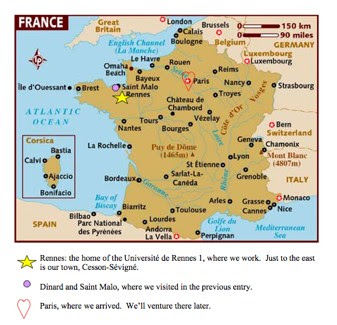First off, just so you know, most of the pictures on our entries can be viewed in a larger format by clicking on them.
We started off this weekend by making a French specialty--the Tarte Tatin aux Pommes. For those of you who don't know it, it's an upside down apple pie, started on the stove and finished in the oven. I had my first version of this when visiting Jean-Claude and Corinne in Paris in 2009. It was amazing. Butter and sugar combine at the bottom of the pan and become caramel with the juice from the apples. My mouth is watering as I write this. My second experience was at Brad's house, and his was superb--the absolute perfect caramel. We collected recipes from friends and the internet and did out best to follow them with the equipment we have now. We made caramel on top of the stove, then put it into a loaf pan, put apples in it, baked those for a while, and put spiced pastry crust on top. Not bad, but way, way too sweet. We'll share a recipe once we have something we like. Most likely, for the upside down version, it will be Brad's recipe. Until then, I think we'll try Elizabeth's recipe, though we might take the handle off of one of our skillets and try that with pears this week until we have a better piece of equipment.
We of course went to the marché to get our fruit and vegetables for the week (including pears for that Tarte Tatin aux Poires), and we took a long walk through our blackberry park. We also walked up to the big grocery store to get some ingredients for meals this week. We got a solid five miles in yesterday!
 |
| Olives! |
We went to the local "Délices de Plantes" garden show down the street from us on Saturday, where we saw our first olive tree, learned all about
sureau, and talked to a beekeeper! The olive tree looked just like a normal tree but with olives hanging from it. It was actually kind of strange to think that the salty little cured things we eat actually come from a tree! The
sureau is an elderberry bush and is apparently very popular here. I always thought elderberries would look like blackberries, but they resemble black currants in both look and taste. Aaron was worried they were poisonous because of misremembering
Arsenic and Old Lace (they put poison into the non-toxic elderberry wine), but when we talked to the man who made the delicacies (Bertrand Bouflet), he informed us that there actually is a very similar plant that is toxic and that you have to know the difference between them. We purchased his elderflower syrup, and it is fantastic! You can see all sorts of recipes
here, but the first we might try is adding it to some club soda. Yum!
 |
| Bees in Brétagne love white asters. |
The beekeeper was very interesting and warmed up to us after we spent about 15 minutes showing our fascination with his bees. He had one of the frames from the hive out (in glass for safety of course), and we could see the drones making honey and caring for the larva. They were also carrying corpses and other unneeded items to the bottom of the frame so that they could continue working. The gentleman was a member of a sort of local guild for apiarists. He said they have lots of classes and internships, so stay tuned for our experiences with that!
 |
Does your church have a
bouncy house? I didn't
think so. |
Today, I started off with a run, and then we went to our first church service here. It's a Roman Catholic one, as almost all are here, but perhaps they will accept us. There must have been at least 600 people there! Of course, it's the only church in town, but still, I think it was a lot. We caught most of what was going on in the service since it's very similar to the Episcopal service, but we didn't know the exact translation of any of the responses. The music was excellent; they had both a children's and adult choir, complete with a long-haired conductor.
 |
| The duck pond. |
 |
Aaron, with cream puff and
coffee. |
The church hosted a
kermesse ("church mass" from the Dutch, something like a local carnival), which came with a bouncy house, more singing from the children's choir, carnival games, fair food, and the
perrières, traditional Breton dancers. You can learn all about their costumes
here. The story they danced and narrated was about Merlin teaching the fairy Viviane nine incantations that would create an invisible prison for whomever she wanted for all eternity. The carnival games consisted of the ubiquitous duck pond and a "knock-the-cans-off-the-table." (Aaron thought the food people were just having trouble keeping the cans on the tables until I showed him.) Fair food in Brétagne is crêpes, pastries, cider, and coffee. We both had a cup of coffee, and Aaron picked a cream puff to share. He does love his sweets, and it was a good choice.
For dinner, Aaron is making an
eggplant and chickpea stew with onions and tomatoes from his Greek cookbook. It smells absolutely amazing.
 |
| The Perrières de Cesson. |
This next week is approaching very quickly; we begin a bunch of long days with interviews and make-up classes. I suppose it's time summer break ends, but never fear! We will still have lots of adventures to share with you!























































